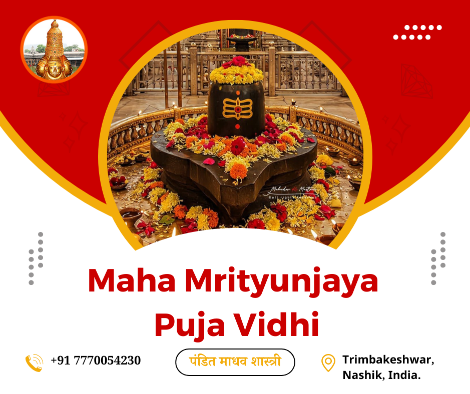
- January 1, 2025
- Pandit Madhav Shastri
- 0
Maha Mrityunjaya Puja Vidhi: Step-by-Step Rituals Explained
In the rich tapestry of Hindu spiritual practices, the Maha Mrityunjaya Puja occupies a sacred space. Revered as one of the most powerful Vedic rituals, this puja invokes the energy of Lord Shiva through the chanting of the Maha Mrityunjaya Mantra—seeking protection from untimely death, healing from ailments, and liberation from fear.
But how exactly is this transformative ritual performed? What are the key components, and what should a devotee prepare before performing or organizing this puja?
In this in-depth guide, we’ll walk you through the complete Maha Mrityunjaya Puja Vidhi—step-by-step—with meanings, materials, and essential tips. Whether you wish to perform it at home, in a temple, or through an online pandit service, this article will help you understand the structure, intention, and sanctity behind the puja.
What Is Maha Mrityunjaya Puja?
The Maha Mrityunjaya Puja is a Vedic ritual dedicated to Lord Shiva, specifically in his aspect as Mrityunjaya—the “Conqueror of Death.” The centerpiece of this puja is the chanting of the Maha Mrityunjaya Mantra:
“ॐ त्र्यम्बकं यजामहे सुगन्धिं पुष्टिवर्धनम्।
उर्वारुकमिव बन्धनान्मृत्योर्मुक्षीय माऽमृतात्॥”
This timeless mantra from the Rigveda (7.59.12) is believed to protect the devotee from premature death (Akal Mrityu), diseases, and fears. The ritual also promotes longevity, health, and spiritual awakening.
Who Should Perform Maha Mrityunjaya Puja?
Although anyone can benefit from this puja, it is especially recommended for:
People suffering from chronic or terminal illness
Those facing dangerous planetary doshas (Kaal Sarp, Pitra Dosh, etc.)
Individuals with fear of untimely death
Families experiencing sudden accidents, losses, or negative energy
Devotees seeking mental peace, spiritual progress, and protection
You can perform the puja yourself, or appoint a qualified Vedic pandit, either in person or online, to do it on your behalf.
What Are the Benefits of Maha Mrityunjaya Puja?
Before we dive into the detailed vidhi, let’s quickly revisit why devotees turn to this sacred ritual:
Healing from physical and mental ailments
Avoidance of accidents and untimely death
Relief from doshas (astrological afflictions)
Peace, protection, and spiritual liberation
Divine grace from Lord Shiva
Step-by-Step Maha Mrityunjaya Puja Vidhi
Now, let us understand the complete Maha Mrityunjaya Puja procedure. This vidhi can vary slightly depending on region or tradition, but the core steps remain the same.
1. Preparation and Purification
Before starting the puja:
Select an auspicious date, preferably on a Monday, Pradosh Vrat, Maha Shivratri, or during Shravan month.
Take a bath and wear clean traditional clothes (preferably white).
Cleanse the puja space with Ganga jal (holy water) or cow dung water.
Place a Shiva Lingam or a photo/idol of Lord Shiva on a raised platform or altar.
Keep all puja samagri (materials) ready.
2. Sankalp (Taking the Vow)
The devotee or pandit takes a Sankalp (spiritual vow), stating the name, gotra (lineage), place, time, and purpose of the puja.
Example:
“I, [Name], son of [Father’s Name], from [Location], take a vow to perform Maha Mrityunjaya Puja for good health, longevity, and protection from negative energies and untimely death.”
This step connects the ritual to the devotee’s intent, making the prayer personal and directed.
3. Gauri Ganesh Puja
No Hindu puja is complete without invoking Lord Ganesha, the remover of obstacles, and Goddess Gauri (Parvati), the divine consort of Shiva.
Offer flowers, sandal paste, and sweets (modaks) to Lord Ganesha.
Chant Ganapati mantras like “ॐ गं गणपतये नमः” to begin the worship.
4. Kalash Sthapana (Establishing the Sacred Pot)
The Kalash, filled with clean water and topped with mango leaves and coconut, is placed as a symbol of divinity.
Chant mantras to invoke holy rivers and deities into the Kalash.
This serves as the seat of cosmic energy throughout the ritual.
5. Navagraha Puja (Worship of Nine Planets)
To mitigate astrological afflictions, the Navagrahas (nine planets) are worshipped:
Sun, Moon, Mars, Mercury, Jupiter, Venus, Saturn, Rahu, Ketu
Offer flowers, rice, and til (sesame seeds) to each graha.
This step neutralizes doshas and promotes harmony with cosmic forces.
6. Invocation of Lord Shiva
Now begins the primary part of the puja:
Chant “Om Namah Shivaya” to invite Lord Shiva’s presence.
Offer bilva leaves, sandalwood paste, white flowers, incense, and deepam (lamp).
You may install a Shiva Lingam or use a photo of Tryambakeshwar, Kedarnath, or Somnath Jyotirlinga.
7. Abhishekam (Ritual Bathing of Shiva Lingam)
This is the most crucial step in the puja. The Shiva Lingam is bathed using:
| Ingredient | Symbolism |
|---|---|
| Milk | Purity and calmness |
| Honey | Sweetness of life |
| Ghee | Spiritual nourishment |
| Curd | Fertility and wellness |
| Sugar | Bliss and energy |
| Water | Life and cleansing |
Each Abhishekam is performed while chanting the Maha Mrityunjaya Mantra. Offer Bilva leaves, which are considered highly sacred to Lord Shiva.
8. Maha Mrityunjaya Mantra Jaap
This is the heart of the puja.
Chant the mantra 108, 1008, or 1.25 lakh (125,000) times.
Use a rudraksha mala and maintain complete concentration.
The chanting can be divided among a group of priests or completed over multiple days.
Each repetition enhances the vibration of healing and protection.
9. Havan (Sacred Fire Ritual)
In some traditions, after the mantra jaap, a havan or homa is performed:
Offer ghee, herbs, rice, and samidha into the fire.
Chant the mantra during each offering.
The fire acts as a medium to carry your prayers to the cosmos.
10. Aarti and Prarthana
The final steps include:
Performing Shiva Aarti with a lit camphor lamp
Singing devotional bhajans (hymns)
Offering prasad (fruits, sweets, coconut)
Conclude the puja with a heartfelt prayer asking Lord Shiva to protect, heal, and bless.
What to Do After the Puja?
After the puja:
Sit in meditation for a few minutes in silence.
Share the prasad with family or the needy.
Donate to Brahmins, temples, or feed cows for added merit.
Continue chanting the Maha Mrityunjaya Mantra regularly for long-term benefits.
Maha Mrityunjaya Puja Samagri List
Here is a checklist of essential items needed for the puja:
Copper Kalash
Coconut
Mango leaves
Milk, curd, honey, ghee, sugar
Bilva leaves
Sandalwood paste
Flowers and garlands
Incense sticks and camphor
White cloth
Rudraksha mala
Rice and turmeric
Fruits and sweets
Shivling or idol of Lord Shiva
Sacred thread (mauli)
Best Days and Muhurat for Maha Mrityunjaya Puja
While the puja can be done any time with devotion, certain days are especially auspicious:
Maha Shivratri
Shravan Somvar (Mondays in the Shravan month)
Pradosh Vrat
Amavasya and Purnima
Birthday or anniversary of recovery
Consult an astrologer or pandit for a personalized muhurat if the puja is for health or dosha removal.
Can the Maha Mrityunjaya Puja Be Done at Home?
Yes. If you have:
A clean puja room
A Shiva Lingam or image
Knowledge of the steps
Guidance from a pandit (in person or online)
…you can perform the puja at home. Alternatively, you can sponsor the puja in temples like Trimbakeshwar, Kashi Vishwanath, or Somnath through trusted services.
Frequently Asked Questions (FAQs)
1. Can I do Maha Mrityunjaya Puja myself at home?
Yes, if you have basic ritual knowledge and devotion. For larger pujas or mantras exceeding 108 recitations, it’s better to consult a priest.
2. How many times should the mantra be chanted during the puja?
Typically 108, 1008, or 1.25 lakh times, depending on the intent. The more you chant, the stronger the energy.
3. Is fasting necessary during the puja?
Not mandatory but recommended. A light Satvik diet, cleanliness, and abstinence from negative speech enhance spiritual energy.
4. Can the puja be done for someone else?
Yes, you can perform or sponsor it on behalf of others, including family members, patients, or friends.
5. What is the ideal duration of the full puja?
Simple home puja: 2–3 hours
Full-scale ritual with 1.25 lakh jaap and havan: 3–5 days
Final Thoughts: A Sacred Path to Shiva’s Grace
The Maha Mrityunjaya Puja is not merely a ritual—it is a spiritual embrace of Lord Shiva’s divine healing energy. Whether you seek protection, peace, or liberation, this sacred vidhi provides a channel for transformation.
Through each step—Sankalp, Abhishekam, Jaap, and Aarti—you invite Shiva into your life, not just as a deity, but as a presence within. In the mantra’s rhythm lies the echo of eternity, calling you toward strength, surrender, and serenity.
May this guide empower you to experience the blessings of the Maha Mrityunjaya Puja in its full glory.
